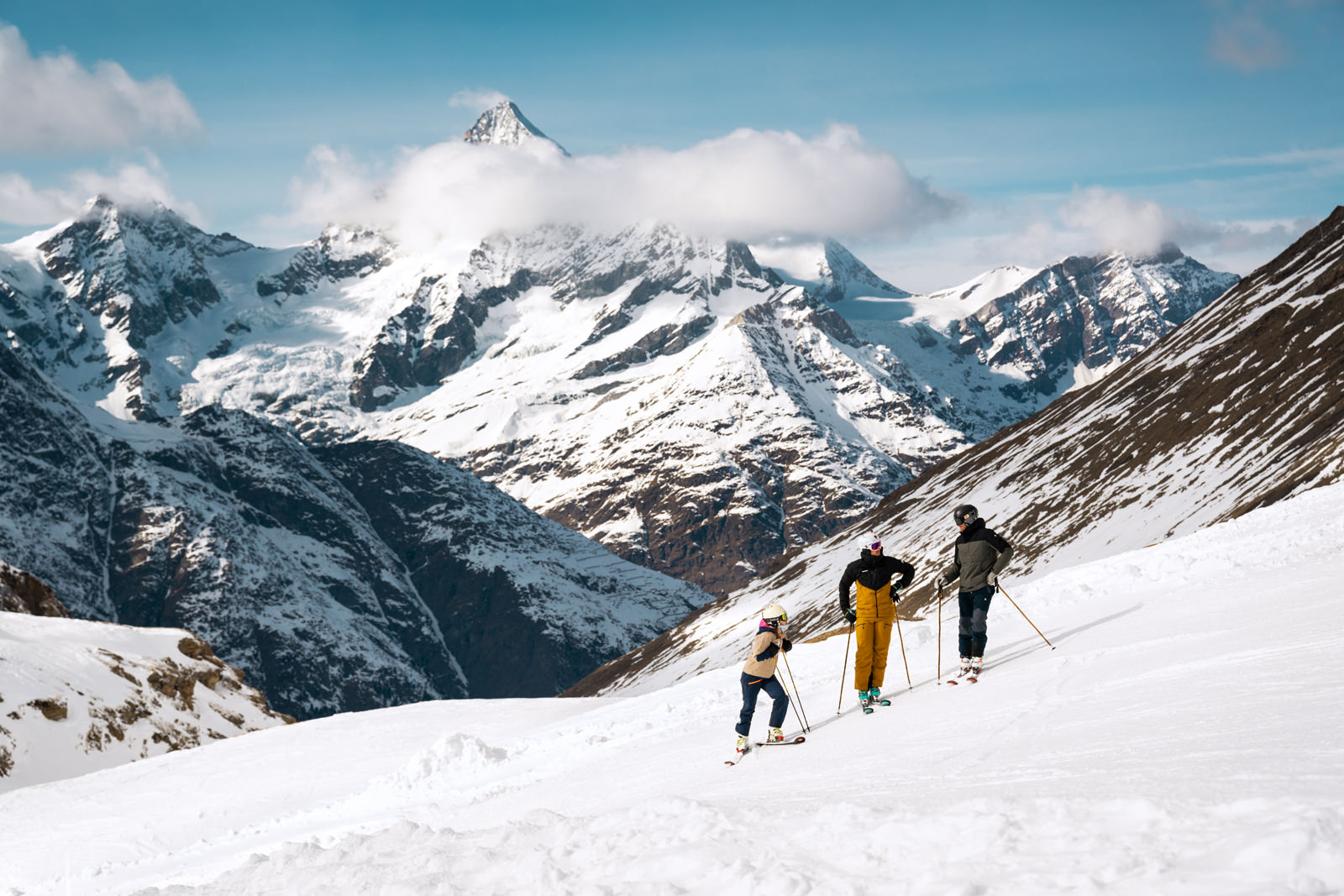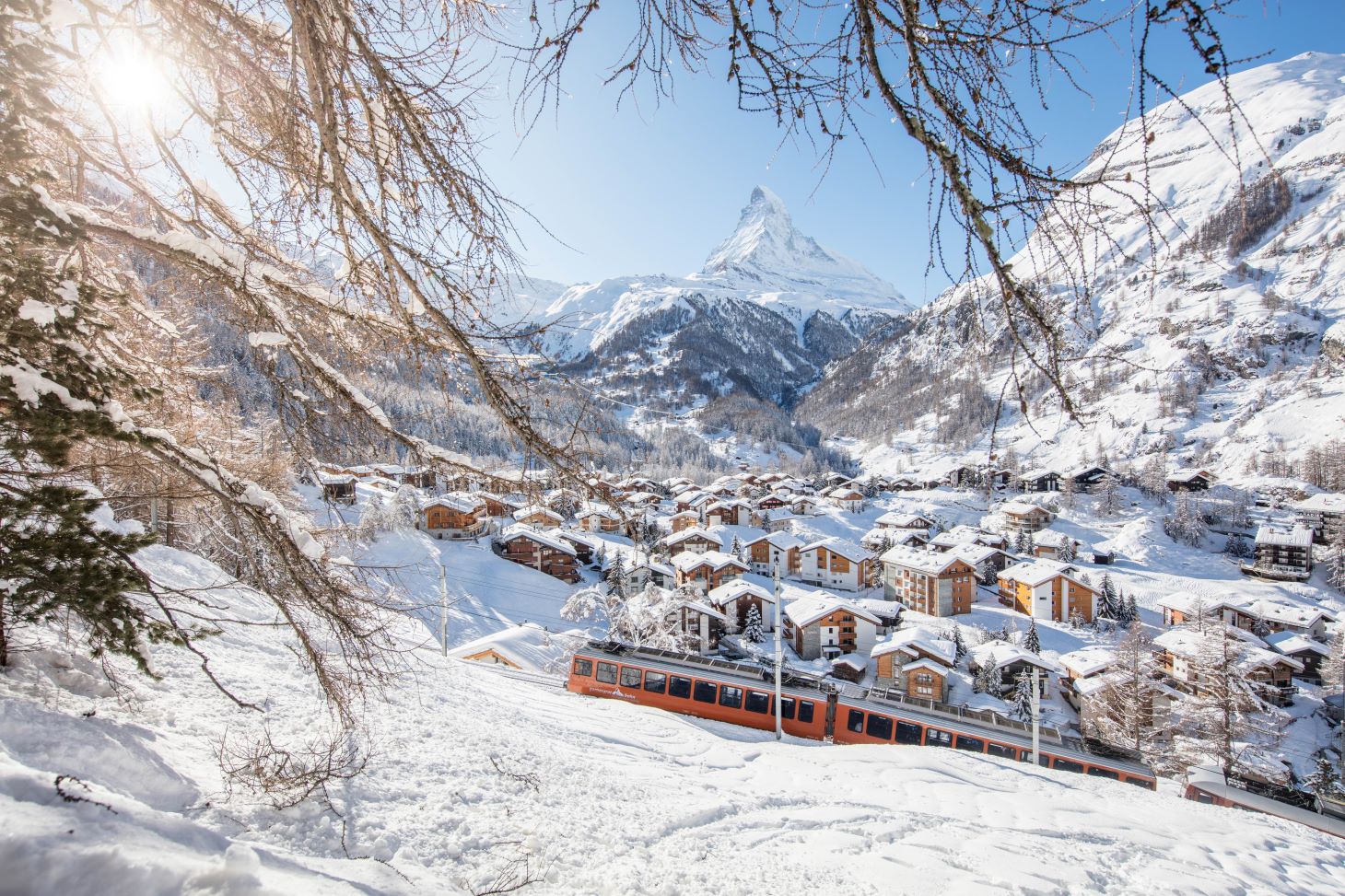
Photo by Nicole Schafer. Courtesy of Switzerland Tourism.
Travel to Zermatt, the Village That Connects the World With the Matterhorn
A stay at The Omnia hotel is a front-row seat to the jewel of the Swiss Alps.
Swiss family traditions thrive in Zermatt—fondue and raclette but also punctuality and privacy. It’s the shepherds, though, herding the shaggy Valais Blacknose sheep through town that are the unexpected delight. Pulling back the curtain at The Omnia at the sound of the “baas” as the flock moves up the path to buildings that are hundreds of years old makes for a sight that transports to a time that was but also to a reality that is. While the town’s population balloons during the peak winter months, the nearly 7,000 year-round residents have managed to prevent it from losing its village feel.

The 30-key Omnia hotel is built on a rock overlooking Zermatt. The wood-and-glass-façade structure is a contemporary interpretation of the classic mountain lodge.
Zermatt is arguably the most famous mountain town in the world, mainly because it sits in the shadow of the world’s most recognizable mountain, the Matterhorn. (So iconic that it has been borrowed for a theme park ride at Disneyland.) It is one of the most visited destinations in Switzerland, which is amazing given that you can only get there by train.
Zermatt is car free, so arriving means leaving your car at the train station in Täsch and taking the 12-minute shuttle train that runs every 20 minutes. Upon arriving in Zermatt, The Omnia-branded electric trolley, one of the few vehicles permitted in the village, will be waiting for you. When you arrive at the hotel, it’s hard not to be impressed as the driver turns off the road and pulls into a narrow tunnel that gives way to frameless glass doors that open to a cavern that is dramatically spotlit. You step out of the trolley and into the elevator that cuts through the rock to connect to the lobby, where hotel personnel welcome you.

The 30-key Omnia is built on a rock overlooking Zermatt. The wood-and-glass-façade structure is a contemporary interpretation of the classic mountain lodge. There is nothing between its south-facing rooms and the Matterhorn, yet it’s only minutes from Bahnhofstrasse, Zermatt’s main street. Interiors are dominated by grey granite, oak, leather, and felt with furniture by Mies van der Rohe, Raymond Loewy, Vladimir Kagan, and Eero Saarinen. As the family that owns The Omnia also founded the USM Haller furniture company, USM designs are also used throughout the hotel. Notable examples include the reception desk, the shelving systems in the suites, and the service wagons the room service and housekeeping teams use. The dropped ceiling is a design feature, with lighting, soundproofing, and heating elements glimpsed through circular and oval cut-outs.
Instead of numbers, hotel rooms—hardwood flooring and white walls—are identified with letters, which are etched on large-format wood keychains for keys that are left at reception when heading out. This being Switzerland, the service is top tier, and The Omnia team will have you set up with rentals from Julen Sport, which provides a complimentary drop-off and pickup service to and from your ski locker. (If The Omnia has a fault, it’s the not-large-enough ski room, which can feel stuffed during the morning rush.)

Interiors are dominated by grey, granite, oak, leather, and felt with furniture by Mies van der Rohe, Raymond Loewy, Vladimir Kagan, and Eero Saarinen.

Zermatt is renowned for skiing, and The Omnia offers easy access to the slopes, which cater to all levels of skiers and are categorized as 21 per cent blue (easy), 61 per cent red (intermediate), and 18 per cent black (advanced). There is a particular specialty in Zermatt, and that is going up to the slopes not by chairlift, gondola, or cable car, but rather in a train. The Gornergrat Bahn brings visitors and skiers up to the Gornergrat station, where there is an observatory, hotel, and restaurant along with a view of the Matterhorn, when it’s clear.
Alternatively, skiers can take the Sunnegga funicular to access the Rothorn side. Or to get to Klein Matterhorn, the highest mountain station in Europe at an altitude of 3,883 metres, take the Matterhorn Glacier Paradise and eventually connect to Plateau Rosa Testa Grigia, from where it’s possible to ski into Italy.
There are numerous hot spots on the slopes, but top spot goes to Chez Vrony, the alfresco mountain restaurant overlooking the Matterhorn. The restaurant is on Rothorn mountain, a short ski down from Sunnegga in the hamlet of Findeln. Housed in a rustic-chic Swiss chalet, it’s been in operation for 100 years and continues to be popular—so lunch reservations are a must. An awe-inspiring spot for a drink (or a few) is the Iglu-Dorf snow bar set against the backdrop of the majestic Matterhorn. There are easy blue runs on the slopes of Gornergrat to access Iglu-Dorf, and loads of loungers to sit back in and bask in the mountain’s beauty when there. Coming down the last stretch of the narrow Sunnegga is the legendary Champagne Bar, a classic après spot decked out in Veuve Clicquot sun yellow, and where the local instructors tend to gather at day’s end and pop a bottle.

Photo by Pascal Gertschen
Back at The Omnia, the indoor/outdoor pool and outdoor whirlpool with a view of the Matterhorn will recharge and reset your legs so you can go back out the next day and do it all over again. Throughout the hotel, there are several lounges, some with fireplaces, that encourage guests to gather. In the restaurant, head chef André Kneubühler puts out a plant-forward menu with meat and fish add-ons, and there are several long tables where new friends can dine together.
Like seeing lions on a safari, the Matterhorn never gets old. The weather changes quickly, and at times it feels like a game of peekaboo as the mountain disappears from view behind the clouds or the fog. When she does reappear, it is always to fresh “oohs and ahhs.” Zermatt is the village that connects the world with the Matterhorn, attracting a crowd that is more interested in doing and seeing things than being seen, though you can still buy a Hublot, Rolex, or Patek Philippe on Bahnhofstrasse.




